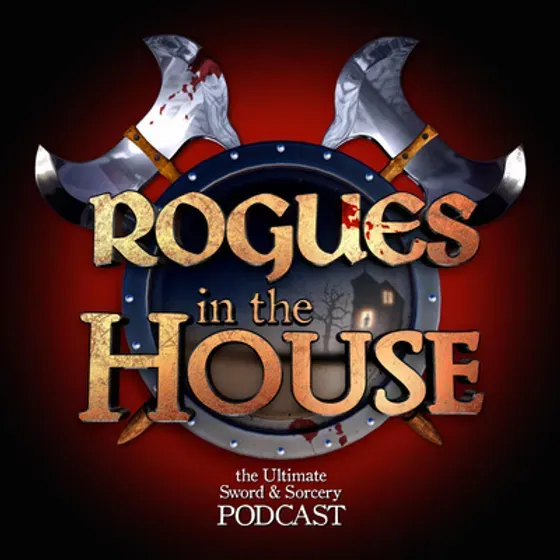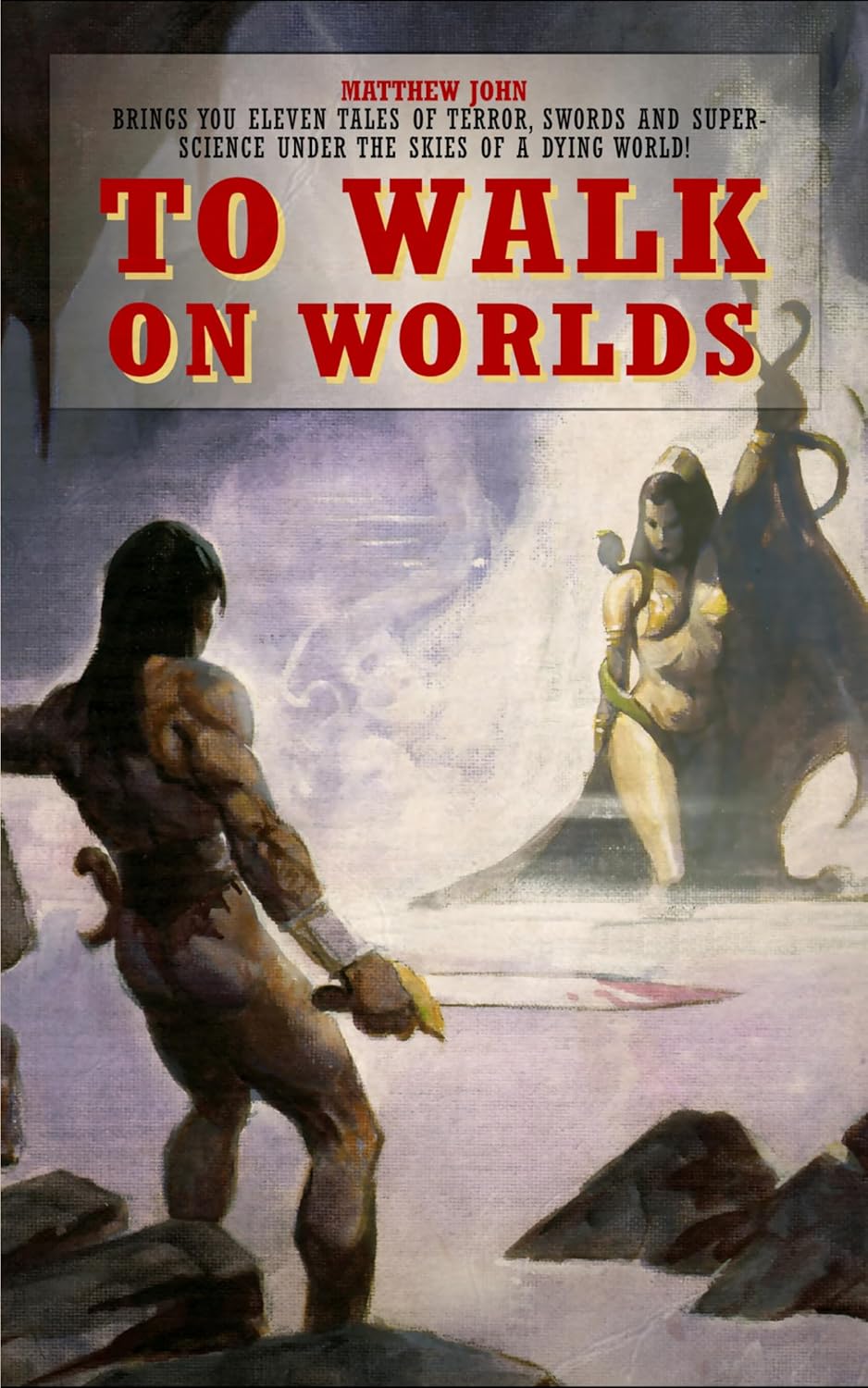The Sword & Sorcery subsect of the fantasy is, in many ways, older than "traditional" fantasy itself. While books like J.R.R. Tolkien's The Lord of the Rings are considered by most to the be foundation for the genre at large, pulp writers like Robert E. Howard (Conan the Barbarian, Kull the Conqueror, Solomon Kane) were crafting their own fantasy worlds decades earlier.
Grittier, bloodier, and more focused on action, Howard's work would become the template for all things Sword & Sorcery for generations to come - almost to the detriment of the subgenre itself. The last several years have seen a new renaissance of writers working to reinvigorate Sword & Sorcery subgenre with new stories that push the boundaries of what was established in the past. Standing tall among these is Matthew John. A member of the Rogues in the House podcast, a game designer, and a Sword & Sorcery author in his own right, John recently responded to some questions about his love of the genre, his career, and his current project - the tabletop RPG Conan the Barbarian - The Hyborian Age, currently on Kickstarter!

Stew Shearer: You have established yourself as one of the prominent figures in the recent Sword & Sorcery revival movement. What is your history with the genre? When did you first become interested in it?
Matthew John: Oh?! Why thank for you for saying so. I hope that’s true. I have been digging on Sword & Sorcery since before I knew what it was. If we look back at old Advanced Dungeons & Dragons and other aesthetics of the 1980s in film, art, games, and comics, we see a look that is fairly removed from the depictions in modern fantasy. The art tends to be darker, with greater contrasts between light and shadow. Everyone is beautiful and a physical specimen. You can see the damn brush strokes on the canvas, too!
When I went to university and began to think more deeply about genre and read Robert E. Howard’s stories and learned of other S&S characters, I began to realize that what I liked had a name. Since that time, I’ve come to separate the real art of the genre from the cheesecake, and now I believe Sword & Sorcery has even more potential. Let’s have fantasy stories where the stakes are personal, the morality grey, where risk and reward are important. Let’s have fun adventure tales, but let’s also keep exploring the human themes at the core of all storytelling. Loincloths and chainmail bikinis are fine, but lets just push beyond that, too!
SS: Most Sword & Sorcery fans have a favorite Howard story. What's your go-to? And are there any S&S gems you encountered while working through the "cheesecake" that you think deserve more attention?
MJ: For Howard, my favorite tale of his remains Worms of the Earth. Bran Mak Morn is out of options and takes desperate actions to spit in the eye of Rome. He invokes horrors, beds a witch to gain her favor, and by the end we get the sense he’s doomed himself. It’s pitch black and has been a major influence on my writing.
For “cheesecake” I kind of enjoy Thongor. In fact, Lin Carter wrote some good Conan stuff, too. Curse of the Monolith is a gem. Bonus answer: If you’ve never watched Deathstalker 2, change that.
SS: Tell me a little bit about the Rogues in the House podcast. How did that first come together?

MJ: Logan, Alex, and I were playing Conan Exiles together online and felt we had a good gift for gab. We experimented by recording an episode, dug it, and went from there. We wanted our show to be rooted in pop culture and various mediums, not just literature, and we’ve been following that thread for a while.
If we have an ethos, it’s that we must laugh. Sure we provide good insights, information, and the facts as we know ‘em, but it’s most important we have fun with one another, and I think our listeners feel that, too. I wish we had a more steady stream of episodes, but we’re all busy boys and have to tackle the paying gigs first.
SS: You are currently deeply involved with Monolith Games' new Conan TTRPG. How did you first connect with Monolith and could you share a bit about what your career there has looked like?
MJ: Social media made it all possible. My Facebook group, the Conan Gaming Group, debuted not too long before Monolith and Modiphius launched Kickstarters for their Conan tabletop games. I began working for Modiphius because they were doing a crossover book between their RPG game and Monolith’s board game. Monolith had sent me a prototype to do some “fan” scenarios for the board game, so I reached out to Modiphius to see if they wanted help writing the crossover book (called The Monolith Sourcebook). They offered me the whole book. After I pinched myself, I wrote the best damned book for them that I could!
During that time, [the company's co-founder] Fred Henry flew me to Paris and offered me a job working directly for Monolith and I accepted. Eventually, after some community management and tons of development for the Conan board game, I convinced them to let me write their Conan RPG.
It is as confusing as it all sounds, but here we are! I’ve written Conan RPG content for two different publishers whose name start with “MO”.
SS: Is there anything you would suggest to one of the countless would-be game makers out there looking to emulate your success?
MJ: Let elegance be your guiding light. I think it’s a mistake to try to simulate a thing with too many rules exceptions and sub systems. I think the appetite for that has waned. If you can accomplish a thing in two steps, don’t make it five.
Also, network. Meet folks. Express interest. When you get your shot, make it a good one. Oh, and really try your best to be a joy to work with.
SS: What have your primary goals been while designing the Conan tabletop RPG? How would you say it differs from other big-name TTRPGs that need not be named?
MJ: We needed a Conan RPG that would be easy to grasp, quick to learn, prep, and play. It needed to feel very Sword & Sorcery in terms of pacing, weirdness, blood and thunder, and forward momentum. Noses should be out of rulebooks for a game like this. Characters should feel powerful and capable but have to keep their wits about them for when the true threats emerge. I want 40+ year-olds running this game to feel like they have the time for it. It doesn’t matter if a few folks drop in or out. It doesn’t matter that you have nothing prepped. It doesn’t matter that you don’t know the system, or how to make a character. This is very show-up-and-play friendly.
It’s also classless. At this point, frankly, another Conan RPG where you must choose a class would be a tragedy. Conan the adventurer/barbarian/rogue/ranger/pirate/soldier/commander does not have one class. Neither should player characters in an RPG dedicated to the man.
SS: One of the gripes I have with some TTRPGs is how long and drawn-out things like combat can be. As a busy grown-up Dad-type myself, could I expect Conan: The Hyborian Age to be a bit swifter when things get bloody?
MJ: YES! I designed it that way. This game should be precisely what you’re asking for.

SS: Talk to me about your short story collection To Walk on Worlds! How long were you working on the various stories for it? Why an anthology of short fiction instead of a novel?
MJ: This anthology has been almost ten years in the making! During that time, I learned to write. I wrote a lot of crap, but even in the early days I found modest publishing success. While I cringe at some of those old stories (and omitted them from To Walk on Worlds), they represent me cutting my teeth. It was time well spent, I suppose.
So what we’re left with is eleven stories, about half of which have been previously published, that are pretty damned good. I recommend reading them in sequence, but they’re all more or less self-contained, as I wrote them for open submission calls. The fun part is, they have many reoccurring characters, settings, themes, and even an overall arc to what’s happening in the world. Book two will lean a little more into a continuity, but readers have seemed to dig this weird offering of tales that is cohesive, but not linked in any mandatory sense.
In short, To Walk on Worlds is Swords & Sorcery meets Grimdark. Super-science! Monsters! Characters who swear and spit and fail as much as they win. It’s got sardonic humor and blood and thunder. It even has an old school cover to tickle that nostalgia.
SS: I definitely dug To Walk on Worlds and Maxus the Meddler was a highlight. How did you go about conceiving and developing him? Were you drawing on any inspirations with his characterization?
MJ: I’m unsure where Maxus came from precisely. I really liked the idea of having a sorcerer, rather than a swordsman, be my main character. Karl Edward Wagner’s Kane definitely inspired this decision–especially since he’s immortal. Eventually, I realized I wanted this through line character who could pop up in several tales or impact the ones in which he didn’t appear. The world building kind of came down to what Maxus required as a character. You’ll see, especially more in Book 2, that he has an arc and isn’t entirely a terrible bastard, though a terrible bastard he remains.
It’s been a blast to consider the mind of a man who wants to learn his craft, from every angle, hoard its secrets, steal secrets from others and abide no challengers. What does he do once he’s caught what he’s been chasing? Are these other worlds on which he walks any better than his own? What happens when another force–a formidable one–threatens the order of his world–the order he so clearly wants to control? In the words of Conan the Destroyer, “we shall see.”

